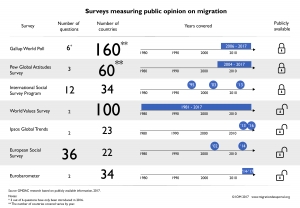Public opinion on migration
Surveys of public opinion on migration are common in many countries. Typically, these polls tend to ask questions about the population’s general views on immigration and immigrants. Public opinion on migration can shape and influence migration policy, although the public may not have an accurate understanding of the number and type of migrants residing in their country. Some evidence suggests it is policy that drives public opinion on migration. Public opinion on migration may also influence the degree to which a migrant integrates into their receiving community. Data on public opinion on migration can be a useful indicator of how open receiving societies are towards immigration and ethnic diversity and can sometimes also indicate different attitudes than what the media suggest.
Definition
Public opinion on migration are the views a population holds towards immigrants, immigration and other related topics. There is a large variation in poll or survey questions that measure public opinion on migration. Some common examples include:
Gallup World Poll
Should immigration in this country be kept at its present level, increased or decreased?
Eurobarometer
How do you feel about immigration - positive or negative?
Would you personally feel comfortable or uncomfortable having an immigrant as your... manager/work colleague/neighbour/doctor/family member/friend?
Pew Research Center
Do you think immigrants make this country a worse place to live?
On the whole, do you think immigration is a good thing or a bad thing for this country today?
Would you like to see the level of immigration in this country increased, decreased or remain about the same?
European Social Survey
Is immigration bad or good for the country’s economy?
Would you say that people who come to live here generally take jobs away from workers or generally help to create new jobs?
Would you like to have an immigrant as a neighbor?
International Social Survey Program (ISSP)
Do you think immigration increases crime rates?
Do you think immigrants should adopt our culture?
Ipsos Global Trends
Do you agree with the following statement: “There are too many immigrants in my country”?
Do you agree with this statement: “People in my country are more negative about immigrants or other groups that are different from them than they were a few years ago”?
Key trends
Globally, public opinion is divided on the question of whether to increase, decrease or keep present immigration levels. On average across the world in 2015, 34 per cent would like to have seen immigration decreased, 21 per cent increased, and 22 per cent kept at its level at the time (IOM, 2015).
Nationally representative surveys conducted by the Pew Research Center in 17 advanced economies in 2021 show that the majority in most of the surveyed countries responded that having people from many different backgrounds - such as diverse ethnic groups, race and religions - improved their society (Pew Research Center, 2021). Among the countries surveyed, Singapore had the highest share of positive responses (92%) followed by New Zealand (88%), Canada and the United States of America (both 86%). Japan had the lowest share of positive responses (39%) followed by Greece (45%) and the Republic of Korea (59%) (ibid.). Despite the positive views, discrimination was identified to be "at least a somewhat serious problem" in most countries surveyed. Perceptions also varied among different age groups, with younger respondents tending to see higher rates of conflict and discrimination within their society than older people (ibid.).
In a Standard Eurobarometer survey conducted in summer 2021, respondents within the EU identified immigration as the second most important issue facing the EU (mentioned by 25 per cent of the respondents, an increase of 7 percentage points from the survey in winter 2020-2021), in joint place with the environment and climate change (European Commission, 2021). In a 2022 Eurobarometer survey entitled the Special Eurobarometer on the Future of Europe, migration issues were among the four most mentioned challenges by respondents in the EU (31% of respondents) and forced migration and displacement was mentioned by some 30 per cent as a global challenge (European Commission, 2022).
Four out of five countries west of Ukraine have seen improved attitudes to migrants in 2022 compared to 2019 (Gallup, 2023a). In the Republic of Moldova (the fifth country) attitudes towards migrants improved from 2016 to 2019 and then remained steady to 2022 (ibid.).
In the United States of America, between January 2022 and February 2023, satisfaction with the level of immigration fell from 34 per cent to 28 per cent, the lowest satisfaction level in the last 10 years (Gallup, 2023b). Of the respondents dissatisfied with immigration, 40 per cent wanted a decrease in immigration, an increase from 35 per cent in 2022 and 19 per cent in 2021 (ibid). In 2023 8 per cent of all respondents wanted an increase in immigration, a decrease from 9 per cent in 2022 and 16 per cent in 2021, the latter of which is the highest since 2021. 15 per cent were unsure or wanted the level to remain the same in 2023, keeping the share of respondents steady from 14 and 15 per cent in 2022 and 2021 respectively (ibid.)
A host of factors drive public opinion on immigration. Factors include the size, origin, religion, and skill level of immigrants, the economy of the receiving country, as well as a number of individual characteristics of the survey respondents such as age, education and employment status.
Back to topData sources and measurement
Data on public opinion are derived from sample surveys. Numerous national opinion surveys include questions on immigration and ethnic diversity. There have been a number of attempts to compare public opinion about immigration at the international level. The following sources collect data on public opinion on immigration via standardized surveys in multiple countries and areas of the world.
The Gallup World Poll is a globally comparable survey, which produces data on public opinion about key issues, including migration. Since 2016, the poll has covered more than 160 countries. Migration-relevant questions in the survey collect data that measure attitudes towards immigration and how perceptions on job competition between immigrants and native workers on the labor market affect host societies’ attitudes. The survey is conducted on an annual basis.
To measure the extent of people’s acceptance of migrants, Gallup created a migrant acceptance index. This new tool gauges people’s perception towards immigrants living in the country, an immigrant becoming a neighbour, and an immigrant marrying a close relative. The highest migrant acceptance index is 9.0. Data are based on three questions, and the survey was last conducted in 145 countries in 2019.
The International Social Survey Program (ISSP) conducts surveys covering a wide range of themes relevant to social science research. The surveys enable users to implement cross-cultural or cross-national perspectives to individual studies. The ISSP consist of 12 modules, one of which provides data on attitudes towards minorities, immigrants (scale), the number of immigrants in the country and patriotism. This module is referred to as the national identity module. It was first updated in 1995, followed by 2005, 2013 and is under development for 2023.
The World Values Survey (WVS) enables users to understand changes in the beliefs, values, and motivations of people throughout the world. The WVS collects nationally representative data through a survey on public opinion and immigration in over 100 countries, and measures changes in views towards immigration. The survey poses statements that address prominent public opinion discourse on immigration such as whether people would like or not like to have immigrants/foreign workers as neighbours, or whether when jobs are scarce, employers should give priority to native-born people over immigrants. The survey is carried out in "waves", with the first (World Values Survey Wave 1) carried out from 1981-1984 in 11 countries. The current database is compiled from the World Value Survey Wave 7, which was conducted in the course of four years 2017-2022.
The Pew Global Attitudes Survey covers a range of subjects, including people’s views towards different immigration-related topics such as who is allowed to stay and work in the country, the immigration-crime nexus, and the effect of immigrants on the economic development of a host country. Since 2004, the survey has covered more than 60 countries. Data on public opinion of migration are updated on an annual basis, but the number of countries varies. The Global Attitudes Survey was conducted in 18 countries in 2022 and 16 countries in 2021.
Ipsos Global Trends conducts an online survey across 23 major countries to assess a broad range of attitudes and beliefs towards prominent topics such as the presence of immigrants. The survey is updated every three years and therefore allows researchers to examine changes in attitude towards immigrants.
The European Social Survey (ESS) conducts a cross-national survey to measure people’s attitudes and beliefs towards social and political realities across Europe. The module on immigration and asylum issues collected data in 2002, was updated in 2014, and is due to be fielded in 2025. Questions included in this survey measure knowledge about immigration and attitudes towards immigration, types of migrants and racism.
The standard Eurobarometer Survey is conducted bi-annually in European Union member states. The survey includes migration-related questions which collect data on Europeans’ attitudes towards the immigration of people from other European Union (EU) Member States and the immigration of people outside the EU. The latest standard Eurobarometer survey was conducted in winter 2021-2022 and an additional Special Eurobarometer Survey was conducted in 2021, exploring public opinion on immigrant integration in the EU.
The Observatory of Public Attitudes to Migration (OPAM) draws together existing data on public opinion across the EU to enhance the understanding of attitudes towards migration. Based on existing data, the Observatory provides descriptive and robust data on attitudes towards migration across the EU member states. It also presents the digest of public opinion data on migration at sub-regional and country-specific levels within Europe.
Back to topData strengths & limitations
Public opinion polls or surveys on migration offer ways to measure attitudes towards a variety of migration-related issues, such as immigration levels, policies, and immigration’s effect on crime, among others. A number of data sources also cover multiple countries, allowing for comparative analysis.
However, these data sources are subject to common challenges in survey methodology, including the following:
Data may not be representative: Data from opinion polls should be collected in a random sample so that everyone in the population being studied has an equal chance of participating. Otherwise, the results could be biased and not representative of the population.
Respondents may interpret same questions differently: Different respondents understand or interpret the same survey questions differently. This is considered a measurement error. For example, the word “migrant” in a survey can mean different things to different people. Some may think migrant means asylum-seekers, while others consider migrants to be labour migrants or irregular migrants.
Data do not always show why the public holds certain views on migration: Public opinion polls on migration provide insights into the public views on migration-related issues, but they do not always explain why people hold certain views or they could change their minds.
Questions in polls tend to focus on asking the general public about immigration rather than emigration: This means surveys that focus on people’s attitudes towards immigration are less relevant to countries with low immigration and high emigration rates. Therefore, in order to gauge a population’s general views on emigration, surveys should include questions about emigration or returning migrants.
Further reading
| International Organization for Migration (IOM) | |
|---|---|
| 2015 | How the World Views Migration. IOM’s Global Migration Data Analysis Centre, Geneva. |
| Dennison, J. and Geddes, A. | |
| 2021 | Thinking Globally about Attitudes to Immigration: Concerns about Social Conflict, Economic Competition and Cultural Threat. The Political Quarterly, Vol. 92, No. 3: 541-551 |
| International Centre for Migration Policy Development | |
| 2018 | Public attitudes on migration: rethinking how people perceive migration. An analysis of existing opinion polls in the Euro-Mediterranean region. EU |
| Hainmueller, J. and D.J. Hopkins | |
| 2014 | Public Attitudes toward Immigration. Annual Review of Political Science 17: 225-249 |
| Heath, A. et al. | |
| 2016 | Attitudes towards Immigration and their Antecedents. Topline Results of the European Social Survey, Issues 7, London |
| Kosho, J. | |
| 2016 | Media Influence on Public Opinion Attitudes toward the Migration Crisis. International Journal of Scientific and Technology Research, 5(5): 86-91 |
| IZA – Institute of Labour Economics | |
| 2017 | Public Opinion on Immigration in Europe: Preference versus Salience. IZA – Institute of Labour Economics, Bonn. |
| Migration Policy Centre (MPC), European University Institute (EUI) and Robert Schuman Centre for Advanced Studies (RSCAS) | |
| 2017 | Explaining Attitudes to Immigration in France. MPC and EUIRSCAS, Italy. |
| 2017 | The Dutch aren’t turning against Immigration – the Salience of the Immigration Issue is what drives Wilders’ Support. MPC Blog Debate Migration, 3 March. |
|
Pew Research Centre |
|
| 2016 | European Opinions of the Refugee Crisis in 5 Charts, Pew Research Centre, 16 September. |
| 2014 | A Fragile Rebound for EU Image on Eve of European Parliament Elections: Chapter 3. Most Support Limiting Immigration. Pew Research Centre, 12 May. |
| The Migration Observatory at the University of Oxford | |
| 2016 | UK Public Opinion toward Immigration: Overall Attitudes and Level of Concern. The Migration Observatory, Oxford |




